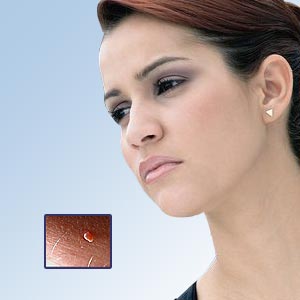Skin Tag Removal

A skin tag is a small, common, soft but harmless skin growth. It is defined as a benign growth of the skin that is connected to the body by a short stalk. Skin tags appear like lesions that appear to hang off the skin. There are various methods to remove skin tags. No health insurance plan covers skin tag removal since it is most often removed for cosmetic reasons. Find out more on identifying skin tags and understanding their removal process.
Skin tags
Skin tags are also known as acrochordons, Pappillomas, Soft fibromas and Pedunculated Filiform (meaning they are on stalk and thread like). Skin tags can vary a bit in appearance. They may appear smooth or irregular, flesh colored or more deeply pigmented. They can either simply be raised above the surrounding skin or have a stalk. Skin tags normally range in size from 1mm to 5 cm. Skin disease conditions like seborrhoeic keratoses, viral warts or molluscum contagiosum resemble skin tags.
Skin tags are most commonly found in the skin folds on the armpits, neck, eyelids, upper chest, and torso, beneath the breasts, genital area and groin. Skin tags occur more in middle-aged women with excess weight and elderly men. Skin tags are asymptomatic. A skin tag may first appear as a tiny soft bump in the skin. Over time, it grows into a flesh colored piece of skin and gets attached to the skin surface by means of a stalk. It is easy to move or to wiggle a skin tag back and forth.
Usually skin tags cause no harm except that they are unattractive to look at. Skin tags generally cause no symptoms unless they are repeatedly irritated. Sometime they can cause irritation if clothing or nearby skin rubs against skin tags. In such cases they can hurt or bleed. If a skin tag is twisted on its stalk, a blood clot can develop within it and the skin tag may become very painful. Skin tags are not cancerous or precancerous growth.
Causes of skin tags
- Irritation or chaffing caused from skin rubbing together.
- During pregnancy, when there is a high level of growth factors.
- Skin tags can occur if insulin resistance, syndrome X persists.
- Skin tags can also be caused by wart virus, known as human papilloma virus.
- Obese persons tend to get skin tags.
- Skin tags also seem to occur more in persons affected by type 2 diabetes mellitus.
Skin tag removal
Most doctors recommend removal of skin tags only when it is absolutely necessary. Removal becomes essential when skin tags are irritated and sore by rubbing of clothing or jewelry, they become a source of discomfort or they constitute a cosmetic problem. Otherwise skin tags require no treatment.
A dermatologist can easily remove a skin tag by burning it off with electric needle or by cutting it off with a scalpel or scissors. Usually the healing process takes a week or two. New skin tags may be formed even if the existing tags are removed. In some people, skin tags tend to disappear if they take chromium picolinate 200 mcg twice a day. This trace element is available in food or drug stores.
Chromium polynicotinate mineral is also sold under the name Natrol Chromemate. This mineral must be taken for three months to see results. If you stop taking the chromium, the tags will recur. However it is always advised to consume this drug only on medical advice.
Traditionally, skin tags were being removed by tying the base of the tag very tightly with a piece of cotton and then waiting for them to drop off as the blood supply is obstructed and the skin tag dies naturally. This method can lead to infection. Some people even try electric bands and they work on the same principle as the cotton band method. No health insurance plan normally pays for removal of skin tags as skin tags are removed only on cosmetic concerns.
Methods to remove skin tags
- Cryotherapy (Freezing the tag with liquid nitrogen)
- Surgical excision (With scalpel or scissors)
- Electrosurgery (Diathermy)
- Ligation (A suture is tied around the neck of the skin tag)
Skin tags may be removed by any of the above methods after injecting a small amount of a local anesthetic. Antiseptic cleansing thereafter would prevent infection. If bleeding occurs, it is usually stopped with a chemical called aluminum chloride or electric - cauterizing treatment. If it is not obvious that the skin growth is a skin tag, the doctor may want to send a biopsy which means the doctor will remove a small piece of skin to be examined in a laboratory to find out if it is malignant or not.
Top of the Page: Skin Tag Removal
Tags:#skin tag #remove skin tag #skin tag removal
 Beauty
Beauty Cosmetic Surgery
Face
Cheek Implants
Mini Facelift
Non Surgical Face Lift
Eyebrow Transplantation
Cosmetic Eye Surgery
Ear Plastic Surgery
Rhinoplasty
Chin Liposuction
Cosmetic Dentistry
Facial Cosmetic Surgery
Chin Surgery
Reconstructive Facial Surgery
Body
Sublative Rejuvenation
Lower Body Lift
Anti-ageing Cosmetics
Wart Removal
Mole Removal
Breast Augmentation
Liposuction
Liposuction Surgery
Cosmetic Laser Surgery
Spider Vein Laser Surgery
Abdominal Liposuction
Umbilicoplasty Surgery
Plasma Skin Resurfacing
Skin Tag Removal
Top of the Page: Skin Tag Removal
Popularity Index: 100,886

